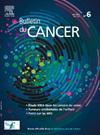Place de la radiothérapie en conditions stéréotaxiques dans les cancers bronchiques non à petites cellules localisés
IF 1.1
4区 医学
Q4 ONCOLOGY
引用次数: 0
Abstract
Le traitement des cancers bronchiques non à petites cellules (CBNPC) de stade précoce T1-T2N0M0 reposait jusqu'alors sur la chirurgie. Cependant 20 à 25 % des patients s'avèrent inopérables en raison de leur âge, de leurs comorbidités, ou refusent la chirurgie. Depuis 2018, la radiothérapie en conditions stéréotaxiques (RCS) est devenue le traitement de référence pour ces patients. Pour les patients opérables, la comparaison chirurgie/RCS s'avère difficile sans conclusion claire, les différents essais de phase III n'ayant pas permis pour l'instant d'apporter de réponse formelle en termes de contrôle local et de survie par défaut d'inclusion. La dose et le fractionnement doivent être choisis en fonction de la localisation de la tumeur. La tolérance est habituellement bonne avec peu de toxicités de grade ≥ 3; cependant la prudence est de mise pour les tumeurs ultracentrales et en cas de pneumopathie interstitielle sous-jacente. La surveillance de l'imagerie postthérapeutique est complexe, avec parfois des incertitudes entre séquelles postradiques et rechute. Cette complexité pourrait s'accroître dans les essais en cours combinant RCS et immunothérapie.
The treatment of early stage T1-T2N0M0 non-small cell lung cancers (NSCLC) was previously based on surgery. However, 20 to 25% of patients are inoperable due to their age, comorbidities or refuse surgery. Since 2018, stereotactic body radiation therapy (SBRT) has become the standard treatment for these patients. For operable patients, the comparison surgery - SBRT is difficult without a clear conclusion, the different phase III trials have not yet permitted to provide a formal answer in terms of local control and survival by default of inclusion. Dose and fractionation need to be selected according to tumor location. Tolerance is usually good, with few grade ≥3 toxicities; however, caution is advised for ultra-central tumors and in case of interstitial pneumonia. Post-therapeutic imaging monitoring is complex, sometimes with uncertainties between radiation-induced pneumonitis and relapse. This complexity may increase in ongoing trials combining SBRT and immunotherapy.
求助全文
约1分钟内获得全文
求助全文
来源期刊

Bulletin Du Cancer
医学-肿瘤学
CiteScore
1.90
自引率
16.70%
发文量
224
审稿时长
37 days
期刊介绍:
Without doubt, the ''Bulletin du Cancer'' is the French language publication of reference in the field of cancerology. Official organ of the French Society of Cancer, this journal covers all the information available, whether in the form of original articles or review articles, but also clinical cases and letters to the editor, including various disciplines as onco-hematology, solids tumors, medical oncology, pharmacology, epidemiology, biology as well as fundamental research in cancerology. The journal proposes a clinical and therapeutic approach of high scientific standard and regular updates in knowledge are thus made possible. Articles can be submitted in French or English.
 求助内容:
求助内容: 应助结果提醒方式:
应助结果提醒方式:


